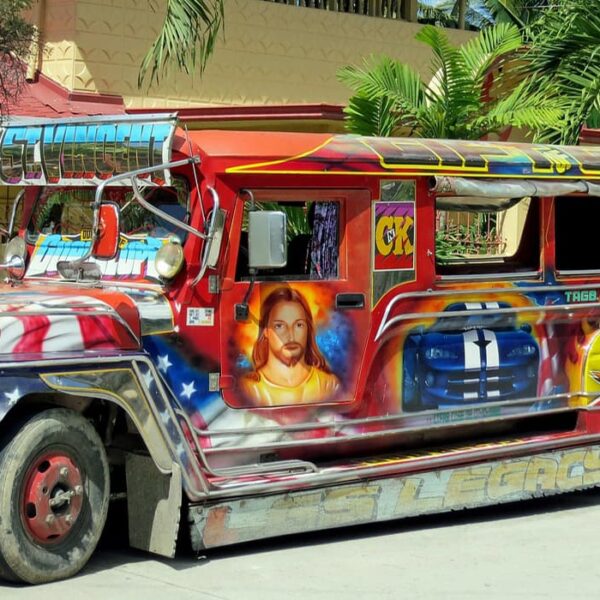While in Thailand the national means of transportation is the tuk-tuk, in the Philippines it is the jeepney or jeepney. This is the name of the buses that run all over Manila and other major cities. At first I wanted to write about all transportation in the Philippines, but after seeing my collection of jeepneys, I decided to dedicate a whole article to them. You could say that they have already become one of the symbols of Philippine culture.
The jeepney got its name from the American Willys, which was left in large quantities after World War II. The war legacy was not disinterested. The Americans were selling jeeps for $200.
Local craftsmen converted the interior into a small covered truck and painted it to their liking. The result was a kind of symbiosis between a jeep and a minibus.
These homemade cars carried goods or were used as public transportation in large cities. Now an additional function has been added – jeepneys have become a tourist attraction in the Philippines. Tourist stores sell pictures of the buses and their toy models. Special chic are the little jeepneys made out of beer cans.
These days, jeepneys are made in private factories and assembled by hand. The best known of these is Sarao Motors.
The jeepney buses are very similar to the Thai songteo: entrance to the passenger compartment in the back, two benches on the sides and natural air conditioning in the form of wind. Such buses are a symbol of the Philippine public transportation subculture.
The body of the jeepney is handmade from tin sheets, the seats are stuffed with coconut coir, a windshield is inserted, and then painted with a regular paintbrush. The cost of such a vehicle starts at $10,000. There are individual specimens for which the price is higher.
Whereas Thai songhtses vary by city and region, in the Philippines you won’t find two jeepneys that are the same. Even in Manila, every bus is unique.
Owners treat their vehicles with soul: paint to their taste, hang lights, decorate with stickers. This is how a vehicle gets its soul.
Nowadays, you can have a jeepney painted at the factory. The Philippines is a pretty religious country, so you can see the slogans “God is love” or “Guide us, oh Lord” on the buses.
In some major cities in the Philippines, jeepneys are assembled from imported Japanese pickup trucks, making them look like gangsta rapper cars.
Manila jeepneys look more like hippie buses from the distant ’70s: “God is love” on the bottom and an ice cream ad on the spare tire.
Actually, these are prop spare wheels; they have completely bald rubber. Anything you can find is used for decorations. For example, a Mercedes badge absolutely does not mean that the jeepney has anything to do with that brand of car.
This photo shows a tricycle riding on the left side, another form of public transportation that I’ll talk about next time.
On the island of Bohol, in Tagbilaran City, jeepneys are very similar to Thai tuk-tuks or songtaos with two benches.
They are carefully tuned to the delight of passengers and driver. In Thailand, such pictures can only be found on large buses of private companies.
Jeepneys in the Philippines are so unique and a representation of culture that Manila holds a “Jeepney King” contest every year among drivers to choose the most beautiful bus.
Typically, the jeepney is ridden by a driver and a conductor. The latter is also the caller at the stops. In some cases, the role of the conductor is performed by the driver. Then all passengers give him their fare. I’m sure it’s not without “hares”.
The cost of travel in jeepneys is not much – not more than 1 dollar per person. These buses are convenient in that they stop at the request of passengers, not strictly at stops.
The jeepney seats 12-16 people, but during rush hour you may see many more people standing right in the aisle. The more adventurous jump right in.
Jeepneys are so popular that their motifs can be found in prints on clothing, paintings, souvenirs, cartoons and even music videos.
